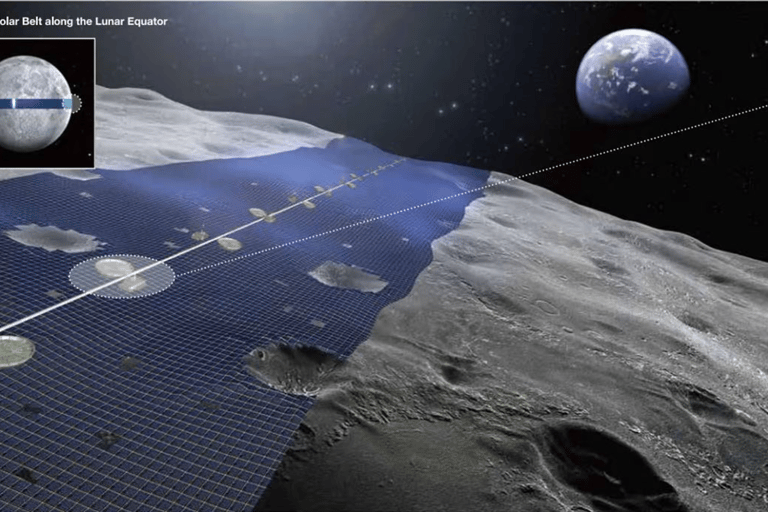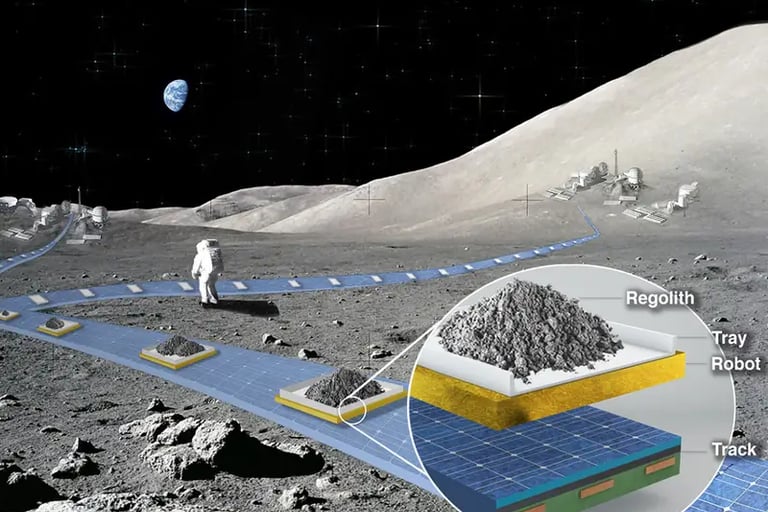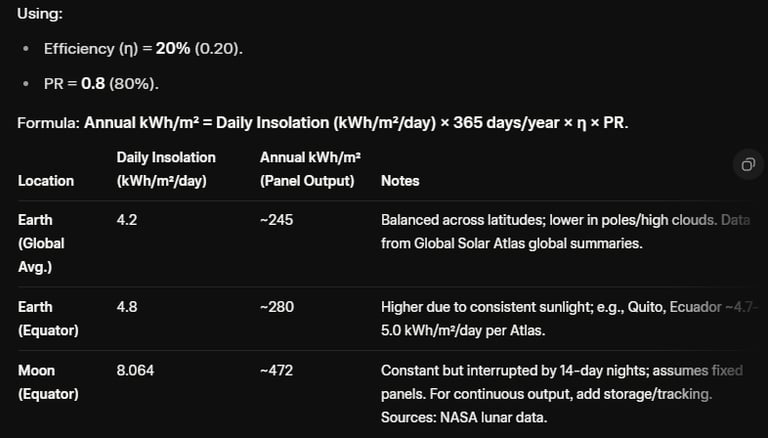1 km² of solar panels on Earth (global avg.) would generate ≈ 245 GWh of electricity per year—enough to power roughly 20 000 average U.S. homes (≈ 12 MWh / home / yr). The same 1 km² on the Moon would yield ≈ 472 GWh, nearly twice as much. While there is potential space on the moon for 2-3 million sqkm of such solar panels on the moon, even a small percentage of this would yield a massive amount of power.
Also, not all solar needs to be PV. Simply polishing metal plates that were manufactured on the moon itself could be used to direct focus sunlight for smelting additional iron regolith into alloys for moon based manufacturing.
Manufacturing on the Moon offers several advantages due to its unique environment and conditions, including:
Low Gravity:
Lunar gravity is approximately one-sixth that of Earth. This lower gravity:
Facilitates easier handling and manipulation of heavy or bulky materials.
Allows for simpler and potentially more efficient manufacturing processes that rely on movement and assembly.
Reduces stress and wear on machinery and structures.
Vacuum Environment:
The Moon lacks a significant atmosphere, providing a vacuum environment that:
Eliminates the need for vacuum chambers typically required on Earth for certain manufacturing processes.
Prevents oxidation and contamination of materials during processing and fabrication.
Facilitates cleaner and purer production of materials, especially those sensitive to atmospheric gases.
Extreme Temperature Variations:
Lunar surface temperatures range from approximately -173°C (-280°F) during lunar night to 127°C (261°F) during lunar day, and get as low as -233 C in craters that never see sunlight. These temperature extremes:
Facilitate easier smelting and processing of metals due to reduced energy requirements for heating and cooling.
Enable efficient thermal management in manufacturing processes, potentially reducing energy consumption.
Allow for the production and testing of materials under extreme conditions, leading to innovations in materials science.
Abundance of Raw Materials:
Lunar regolith (surface soil) contains a variety of minerals and elements, including silicon, iron, aluminum, titanium, and rare earth elements. These resources:
Can be extracted and processed locally for use in manufacturing construction materials, such as concrete-like materials, ceramics, and metals.
Reduce the need for transporting materials from Earth, lowering costs and logistical challenges.
Minimal Geological Activity:
Unlike Earth, the Moon has minimal geological activity such as earthquakes and volcanic eruptions. This:
Provides a stable and predictable environment for manufacturing operations.
Reduces risks associated with natural disasters that could disrupt manufacturing processes on Earth.
Microgravity Environments:
Some areas on the Moon, such as its orbital points called Lagrange points, experience microgravity conditions. This:
Allows for experimentation and production of materials and products that require precise control over gravity effects.
Facilitates research and development in advanced manufacturing techniques, such as additive manufacturing (3D printing) in microgravity.
Long-Term Sustainability and Independence:
Establishing manufacturing capabilities on the Moon supports long-term lunar exploration and habitation:
Reduces dependency on Earth for essential supplies and materials.
Enables self-sufficiency in manufacturing critical components for lunar bases, habitats, and infrastructure.
Technological and Economic Opportunities:
Encourages technological innovation and advancement in robotics, automation, materials science, and space manufacturing technologies.
Creates economic opportunities for commercial ventures in space mining, manufacturing, and research and development.
Overall, the unique combination of low gravity, vacuum environment, extreme temperatures, abundant raw materials, and solar power availability makes the Moon an attractive prospect for developing advanced manufacturing capabilities that could support sustainable lunar exploration and expand humanity's presence in space.
Solar Manufacturing Rail




The idea of using the ample solar power available at moons equator is nothing new (pictured above.) What I propose we consider is using autonomous solar power robots to build a rail structure at the equator that allows the solar array to move with the sun. The Moon’s equatorial circumference is about 10,921 kilometers (6,786 miles) and one rotation takes 27.3 days. You’d need to travel at approximately 10.36 miles per hour (or roughly 16.67 kilometers per hour) along the Moon’s equator to keep up with the Sun, assuming you’re matching the Moon’s rotation to stay in the same spot relative to the Sun’s position overhead.
Once these massive solar arrays are in motion, minimal energy would be required to maintain their velocity using standard rail technology, and even less with an upgrade to maglev technology in the future.
You'll notice solar output is highest on earth in the high deserts of the Andes mountains where earths atmosphere is thinner at high elevation: https://globalsolaratlas.info/ Moon's Advantage: Nearly double Earth's global output (~1.9×) due to no atmospheric losses (~30% absorption/scattering on Earth)




